John K. Watts
John Albert Watts (later known as John K. Watts, 21 January 1937 – 3 June 2017) was an Australian rules football player and radio broadcaster and television personality.[1] He worked in the police force before starting his football career.[2]
| John K. Watts | |||
|---|---|---|---|
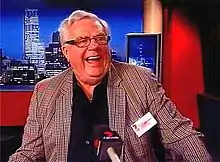 John K. Watts at Channel 7 Studios Perth, 2009 | |||
| Personal information | |||
| Full name | John Albert Watts | ||
| Date of birth | 21 January 1937 | ||
| Place of birth | East Perth, Western Australia | ||
| Date of death | 3 June 2017 (aged 80) | ||
| Original team(s) | Bayswater Juniors | ||
| Height | 191 cm (6 ft 3 in) | ||
| Weight | 94 kg (207 lb) | ||
| Playing career1 | |||
| Years | Club | Games (Goals) | |
| 1954–1962 | East Perth | 166 (9) | |
| 1963–1965 | Geelong | 52 (4) | |
| 1966–1968 | Hobart | 53 | |
| Representative team honours | |||
| Years | Team | Games (Goals) | |
| 1957–1960 | Western Australia | 12 (0) | |
| 1966–1968 | TANFL | 2 | |
| Coaching career | |||
| Years | Club | Games (W–L–D) | |
| 1966–1968 | Hobart | 61 (24-36-1) | |
|
1 Playing statistics correct to the end of 1968. | |||
| Career highlights | |||
| |||
| Sources: AFL Tables, AustralianFootball.com | |||
Football career

Watts debuted for the East Perth Football Club on a half back flank against Subiaco at the age of 17 in 1954 and would become a regular player with the club.[3]
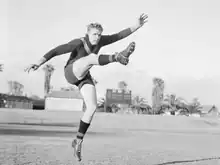
In 1963 he was a member of the Geelong football team.[3] In 1966, Watts moved to Tasmania to Captain/Coach the Hobart Football Club.[3] This success would make him the only Australian rules football player to have played in three premiership sides, for three different teams, in three different states.[4] He retired from playing football in 1968.
It was during these events that he wrote several club anthems. He wrote the East Perth Football Club, Swan Districts and Geelong Football Club theme songs.[4]
In March 2008 he was inducted into the West Australian Football Hall of Fame.[5]
Media career
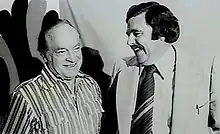
After retiring from football, Watts began working in radio and television. Over a span of 30 years, he worked with multiple television and radio stations. He wrote for comedians Bob Hope and Harry Secombe and made contributions to magazines and published his own joke books.
Watts appeared on TVW 7's inaugural televised Football Panel and World of Sport segments, hosted by Ross Mewburn Elliott. He appeared on the Football and Sports review on Channel 7 News and became a familiar entertainer and panelist on TVW 7's Telethon.[6]
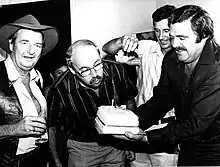
Work with George Chapman

In the early 1970s, John Watts received an offer from George Chapman, the head of Perth Radio Station 6PM, to collaborate with popular DJ and radio producer Barry Martin in creating a ariety-style radio program.
By the late 1970s, they had earned the moniker of the "Dynamic Duo". They welcomed Qantas Airways' first B747 to Perth, promoting the Australind Train Service to Bunbury, and celebrating the relaunch of the Indian Pacific Train Service (for which John Watts penned another song).
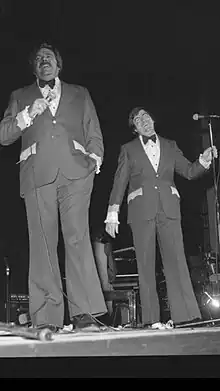
Business career
John K Watts ventured into the world of business and owned several adio stations and hotels in Perth. His entrepreneurial endeavors expanded to encompass various football, horse-racing, and hotel ventures, solidifying his reputation as a highly accomplished businessman.[7]
During this period, Watts had the idea to integrate a West Australian team into the Victorian Football League (now known as the Australian Football League), however, rival factions within the West Australian Football League boycotted this proposal. Unfazed by the opposition, John rallied the support of figures such as Lindsay Fox and Alan Delaney, who shared his vision. Their collective efforts eventually led to the birth of the West Coast Eagles.
Personal life
John Watts had three daughters: Joanna, Donna (deceased), and Venessa, as well as two sons named Luke and Jonathon. Throughout his life, John entered into three marriages. In the year 2000, he married Lorraine Watts, his third wife, in Las Vegas. They resided in Scarborough, a coastal city in Western Australia.
During his lifetime, Watts faced various health challenges. He underwent surgery to remove a malignant melanoma from the back of his neck during his football playing days and continued to play football while recovering. In the year 2000, he was diagnosed with prostate cancer. Later, in November 2011, he received the diagnosis of a form of bone cancer.[4]
On June 3, 2017, Watts died at the age of 80. His departure occurred at his home in Scarborough, where he found solace in the serene presence of the Indian Ocean.[8]
Discography
See also
References
- Les Everett. "A tribute to Watts". australianrules.com.au. Archived from the original on 10 December 2008.
- "WA footy and broadcasting legend John K Watts dead". The West Australian. 4 June 2017. Retrieved 10 September 2023.
- "Australian Football - John Watts - Player Bio". australianfootball.com. Retrieved 10 September 2023.
- Phillips, Yasmine (7 January 2012). "John K Watts cancer blow". The Sunday Times.
- "WA Football Hall of Fame inductees announced". afl.com.au. 10 March 2008. Retrieved 25 November 2008.
- "Obituary: John K Watts". Television.AU. 4 June 2017. Retrieved 10 September 2023.
- "Firefighters contain tavern blaze". ABC Online. Australian Broadcasting Corporation. 27 April 2002. Retrieved 30 March 2009.
- White, Simon (4 June 2017). "WA footy and broadcasting legend dies". PerthNow. Retrieved 4 June 2017.
- Kent, David (1993). Australian Chart Book 1970–1992 (illustrated ed.). St Ives, N.S.W.: Australian Chart Book. p. 334. ISBN 0-646-11917-6.
External links
- "'Fair dinkum, unbelievable' loss" Archived 11 March 2012 at the Wayback Machine: John K. Watts on Davis